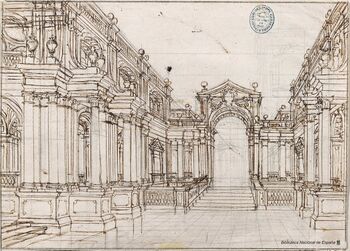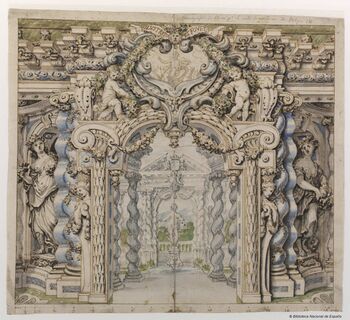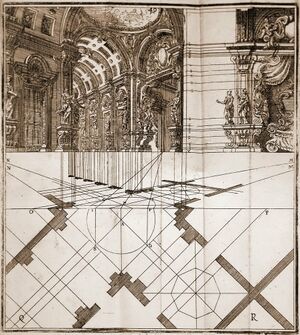The illusion of perspective[edit]
The invention of perspective as a way of drawing that made a picture look visually like reality had a huge impact on scenic design. Perspective scenography dominated the court theatres of Renaissance Italy, and spread across Europe.
Around 1425 Filippo Brunelleschi (Q667) invented a technique for drawing that was consistent with visual experience through an exact geometric construction – perspective. This ‘correct’ construction was later published by Leon Battista Alberti in 1436 with a dedication to Brunelleschi. It can be defined conceptually as a flat intersection of the ‘visual pyramid’. This perspective, this perspicere ‘to see through something’, went on to be used in the design of sets by the architect-engineers, or architect-scenographers, Antonio da Sangallo the Elder, Bastiano ‘Aristotile’ da Sangallo (his nephew), Sebastiano Serlio (Q568), Giorgio Vasari, Bernardo Buontalenti, Giulio Parigi and, during the first half of the 17th century, by Inigo Jones (Q20471), Cosimo Lotti (Q21026) and Joseph Furttenbach (Q60).
Scenic perspective differs from normal perspective in that it includes the third dimension, albeit reduced, not like in paintings or drawings, in which there is no third dimension. Sebastiano Serlio was the first to illustrate the three scenes of the theatre of antiquity (comedy, tragedy and satire), and the first to propose a method for designing scenes in perspective (G.03). In both his tragic and comic scenes, as well as in the theatre with which he illustrates his perspective method for designing theatrical scenes, what is shown is ‘the city’ and this is what Palladio and Scamozzi also show forty years later in the stage of the Teatro Olimpico in Vicenza (Q650).
In the theatre, perspective visually conveys the city as a stage. The trio of city-perspective-theatre, building on the ideas of antiquity, is possibly the most representative scheme of the Renaissance. Theatrical scenery evolved alternating between treatises on perspective and the practice on stage. It was not until 1600, when Guidobatdo del Monte converted perspective definitively into a science by proposing, precisely through his study of theatrical scenes, the geometric concept of the vanishing point as a limit point.
The scene in perspective evolved from the first houses in relief represented on stage, built in the two planes visible to the public (the facade parallel to the front of the stage and the one seen in depth, at an angle and foreshortened), examples of which are the houses on the central street of the Teatro Olimpico in Vicenza, or those of the later Sabbioneta theatre (Q653). In the 17th century, the two façades are represented in a single plane, located parallel to the front of the stage, the pictorial surface of the frame. The perspective effect is achieved by placing a series of flats along the depth of the stage in positions whose interval decreases towards the rear of the stage, and with their inner edge increasingly close to the centre line. In addition, the flats decrease in height and the floor of the stage rises in a rake. This can be seen in the Farnese Theatre of Parma, opened in 1618.
At first, only flats parallel to the front of the stage were used, but later, in order to improve the view for the spectators at the sides of the auditorium, flats were also used in angled positions. One of the first occasions in which oblique wings appear is in the plan of the Theatre of Saints John and Paul in Venice, which dates from 1639. Andrea Pozzo extensively developed the layout of these wings in his treatise.
In the perspective illusionism of the Baroque theatre, the only person who could correctly see the scenic perspective was the monarch, since he was the one who occupied the point of view. The spread of angled scenes – with the vanishing point off to one side, and sometimes two-point perspective – by Ferdinando Galli Bibiena (F.04) at the beginning of the 17th century meant a change in the conception of the space of the stage. The axes of the space represented in the scene, running at an angle to the centre line of the stage, were oriented differently to those of the real space of the room, so there was no sense of continuity between both spaces: the stage and auditorium were visually and conceptually separated. The angled scene therefore makes the represented space more distant and reinforces the idea of illusion, since what was seen on the stage was presented as a portion of reality for the spectator to contemplate, and in this sense create the illusion of it being reality.




